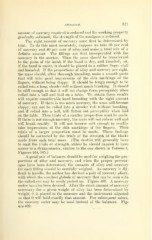Page 657 - My FlipBook
P. 657
AMALGAM. 321
amount of mercury required is reduced and tlie working property
gradually softened ; the strength of the amalgam is reduced.
The right amount of mercury must first be determined by
trial. To do this most accurately, suppose we take 60 per cent
of mercury and 40 per cent of alloy and make a trial mix of a
definite amount. The fillings are first incorporated with the
mercury in the mortar. Then the mass should be transferred
to the palm of the hand, if the hand is dry, and kneaded; or,
if the hand is moist, it should be placed in a rubber finger stall
and kneaded. If the proportions of alloy and mercury are right,
the mass should, after thorough kneading, make a smooth paste
that will take good impressions of the skin markings of the
fingers, without being sloppy. It should be tough enough to be
rolled into a long, slender roll without much breaking. It should
be stiff enough so that it will not change form perceptibly when
rolled into a ball and laid on a table. To obtain these results
will require considerable hard kneading with the right amount
of mercury. If there is too much mercury, the mass will become
sloppy, can not be rolled into a slender roll without breaking,
and if rolled into a ball, will flatten out perceptibly when laid
on the table. Then trials of a smaller proportion must be made.
If there is not enough mercury, the mass will not cohere well and
will break readily. It will not become soft enough to readily
take impressions of the skin markings of the fingers. Then
trials of a larger proportion must be made. These findings
should be corrected by the trials of the strength of the blocks
made from each trial mass. (The dentist will generally have
to omit the trials of strength, unless he should happen to have
access to a dynamometer, similar to the one shown in Volume I,
Figures 164, 165.)
A good pair of balances should be used for weighing the pro-
portions of alloy and mercury, and when the proper percent-
ages have been determined, the amounts of alloy and mercury
for each filling should be carefully weighed. As mercury is dif-
ficult to handle, the author has devised a pair of mercury pliers,
with which the smallest globule of mercury that can be seen with
the naked eye may be easily picked up. Figure 408. A mercury
meter has also been devised. After the exact amount of mercury
necessary for a given weight of alloy has been determined by
weight, it is placed in the measure and the instrument adjusted
so that it will hold exactly that amount. For subsequent mixes,
the mercury meter may be used instead of the balances. Fig-
ure 409.


